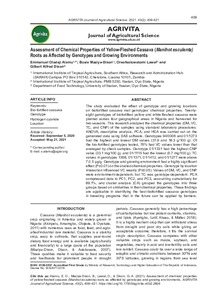| dc.contributor.author | Alamu, E.O. |
| dc.contributor.author | Maziya-Dixon, B. |
| dc.contributor.author | Lawal, O. |
| dc.contributor.author | Dixon, A. |
| dc.date.accessioned | 2021-07-05T09:14:28Z |
| dc.date.available | 2021-07-05T09:14:28Z |
| dc.date.issued | 2021 |
| dc.identifier.citation | Alamu, E.O., Maziya-Dixon, B., Lawal, O. & Dixon, G.A. (2021). Assessment of chemical properties of yellow-fleshed cassava (Manihot esculenta) roots as affected by genotypes and growing environments. AGRIVITA, Journal of Agricultural Science, 43(2), 409-421. |
| dc.identifier.issn | 0126-0537 |
| dc.identifier.uri | https://hdl.handle.net/20.500.12478/7157 |
| dc.description.abstract | The study evaluated the effect of genotype and growing locations on biofortified cassava root genotypes’ chemical properties. Twentyeight genotypes of biofortified yellow and white-fleshed cassava were planted across four geographical areas in Nigeria and harvested for two seasons. This research analyzed the chemical properties (DM, VC, TC, and CNP) of the samples using standard laboratory procedures. ANOVA, descriptive analysis, PCA, and HCA was carried out on the generated data using SAS software. Genotypes 94/0006 and 01/1273 had the highest and lowest DM values (31.9 and 18.3 g/100 g). Of the bio-fortified genotypes tested, 76% had VC values lower than that averaged by check samples. Genotype 01/1331 had the highest CNP value (33.1 mg/100 g), and 01/1115 had the lowest (5.7 mg/100 g). TC values in genotypes 1368, 01/1371, 01/1412, and 01/1277 were above 7.0 5 µg/g. Genotype and growing environment had a highly significant effect (P≤0.01) on the studied chemical properties. Genotype by location interaction influenced VC weakly (P≤0.05). Values of DM, VC, and CNP were environment-dependent, but TC was genotype-dependent. PCA compressed data to PC1, PC2, and PC3, accounting cumulatively for 89.1%, and cluster analysis (CA) grouped the genotypes into three groups based on similarities in their chemical properties. These findings are applicable in identifying the best-biofortified cassava genotypes in breeding programs that in the future can be applied by farmers. |
| dc.format.extent | 409-421 |
| dc.language.iso | en |
| dc.subject | Biofortification |
| dc.subject | Cassava |
| dc.subject | Genotypes |
| dc.subject | Hydrocyanic Acid |
| dc.subject | Location |
| dc.title | Assessment of chemical properties of yellow-fleshed cassava (Manihot esculenta) roots as affected by genotypes and growing environments |
| dc.type | Journal Article |
| cg.contributor.crp | Agriculture for Nutrition and Health |
| cg.contributor.crp | Maize |
| cg.contributor.crp | Roots, Tubers and Bananas |
| cg.contributor.affiliation | International Institute of Tropical Agriculture |
| cg.contributor.affiliation | University of Ibadan |
| cg.coverage.region | Africa |
| cg.coverage.region | West Africa |
| cg.coverage.country | Nigeria |
| cg.coverage.hub | Southern Africa Hub |
| cg.coverage.hub | Headquarters and Western Africa Hub |
| cg.researchtheme | Nutrition and Human Health |
| cg.identifier.bibtexciteid | ALAMU:2021d |
| cg.isijournal | ISI Journal |
| cg.authorship.types | CGIAR and developing country institute |
| cg.iitasubject | Agronomy |
| cg.iitasubject | Biofortification |
| cg.iitasubject | Cassava |
| cg.iitasubject | Food Security |
| cg.iitasubject | Plant Breeding |
| cg.iitasubject | Plant Production |
| cg.journal | AGRIVITA Journal of Agricultural Science |
| cg.notes | Open Access Article |
| cg.accessibilitystatus | Open Access |
| cg.reviewstatus | Peer Review |
| cg.usagerightslicense | Creative Commons Attribution 4.0 (CC BY 0.0) |
| cg.targetaudience | Scientists |
| cg.identifier.doi | https://dx.doi.org/10.17503/agrivita.v43i2.2804 |
| cg.iitaauthor.identifier | Alamu Emmanuel Oladeji: 0000-0001-6263-1359 |
| cg.iitaauthor.identifier | Busie Maziya-Dixon: 0000-0003-2014-2201 |
| cg.futureupdate.required | No |
| cg.identifier.issue | 2 |
| cg.identifier.volume | 43 |

